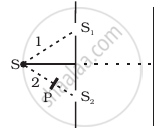Advertisements
Advertisements
Question
Greenlight is an incident at the polarising angle on a certain transparent medium. The angle of refraction is 30°.
Find
(i) polarising angle, and
(ii) refractive index of the medium.
Solution
(i) when the light is incident at the polarizing angle, the angle of refraction and angle of polarization are related according to the equation,
∠ip + ∠r = 90°
The angle of refraction is given as, 30°. So the angle of polarization, ∠ip = 90° - 30° = 60°
(ii) Applying Snell's law, we can write, the refractive index of the transparent media,` mu = sin"i"_"p"/sin "r"`
⇒ `mu = sin60^@/sin30^@ = (sqrt3/2)/(1/2) = sqrt3`
⇒ ` = mu sqrt3`
APPEARS IN
RELATED QUESTIONS
For a glass plate as a polariser with refractive index 1.633, calculate the angle of incidence at which light is polarised.
Show, using a simple polaroid, that light waves are transverse in nature. Intensity of light coming out of a polaroid does not change irrespective of the orientation of the pass axis of the polaroid. Explain why.
What is the Brewster angle for air to glass transition? (Refractive index of glass = 1.5)
Show using a proper diagram how unpolarised light can be linearly polarised by reflection from a transparent glass surface.
With the help of an experiment, state how will you identify whether a given beam of light is polarised or unpolarized?
Unpolarised light is incident on a polaroid. How would the intensity of transmitted light change when the polaroid is rotated?
What is unpolarised light?
What is partially polarised light?
Polarisation of light is the only phenomenon that establishes ______.
Figure shown a two slit arrangement with a source which emits unpolarised light. P is a polariser with axis whose direction is not given. If I0 is the intensity of the principal maxima when no polariser is present, calculate in the present case, the intensity of the principal maxima as well as of the first minima.

